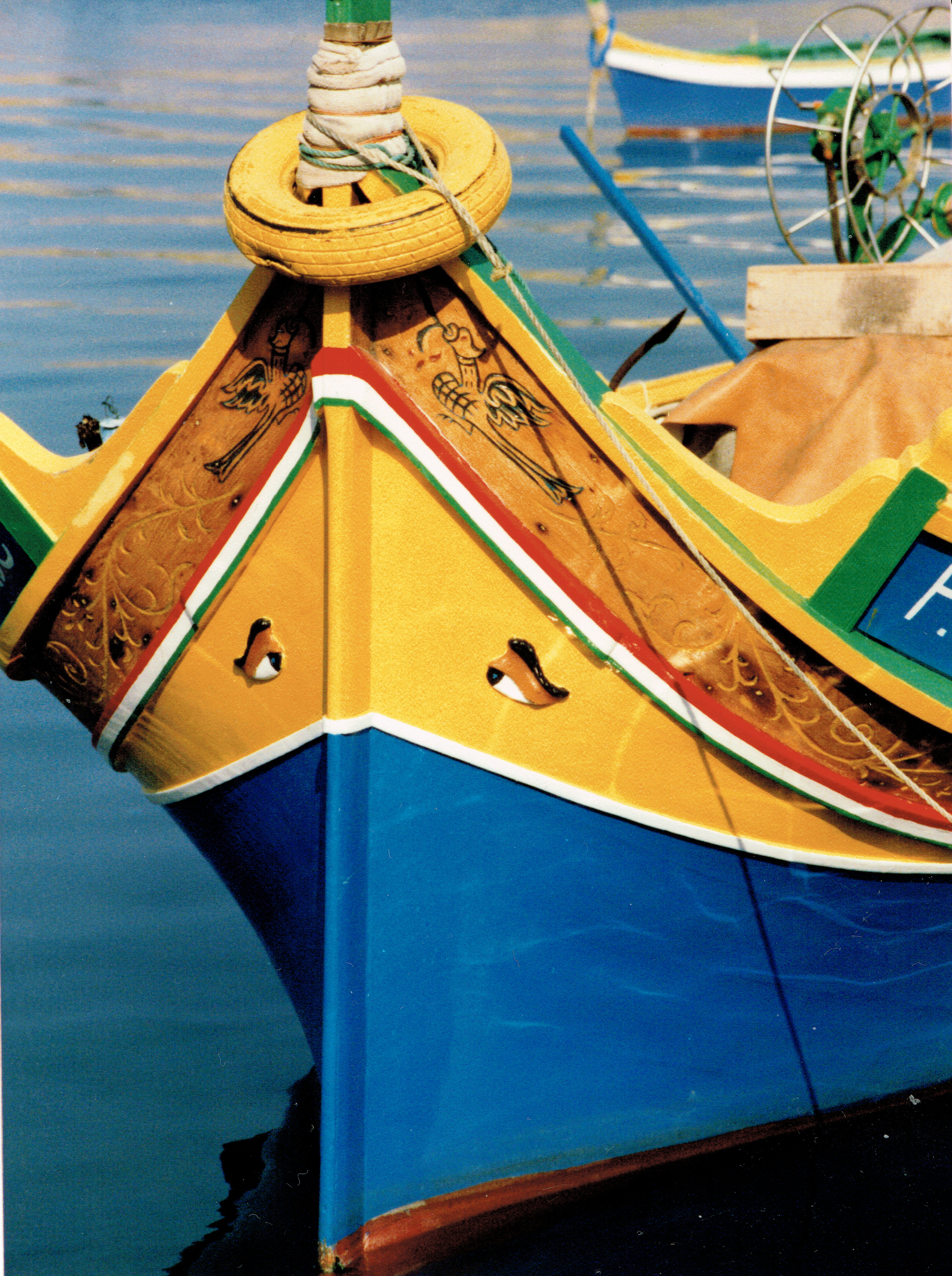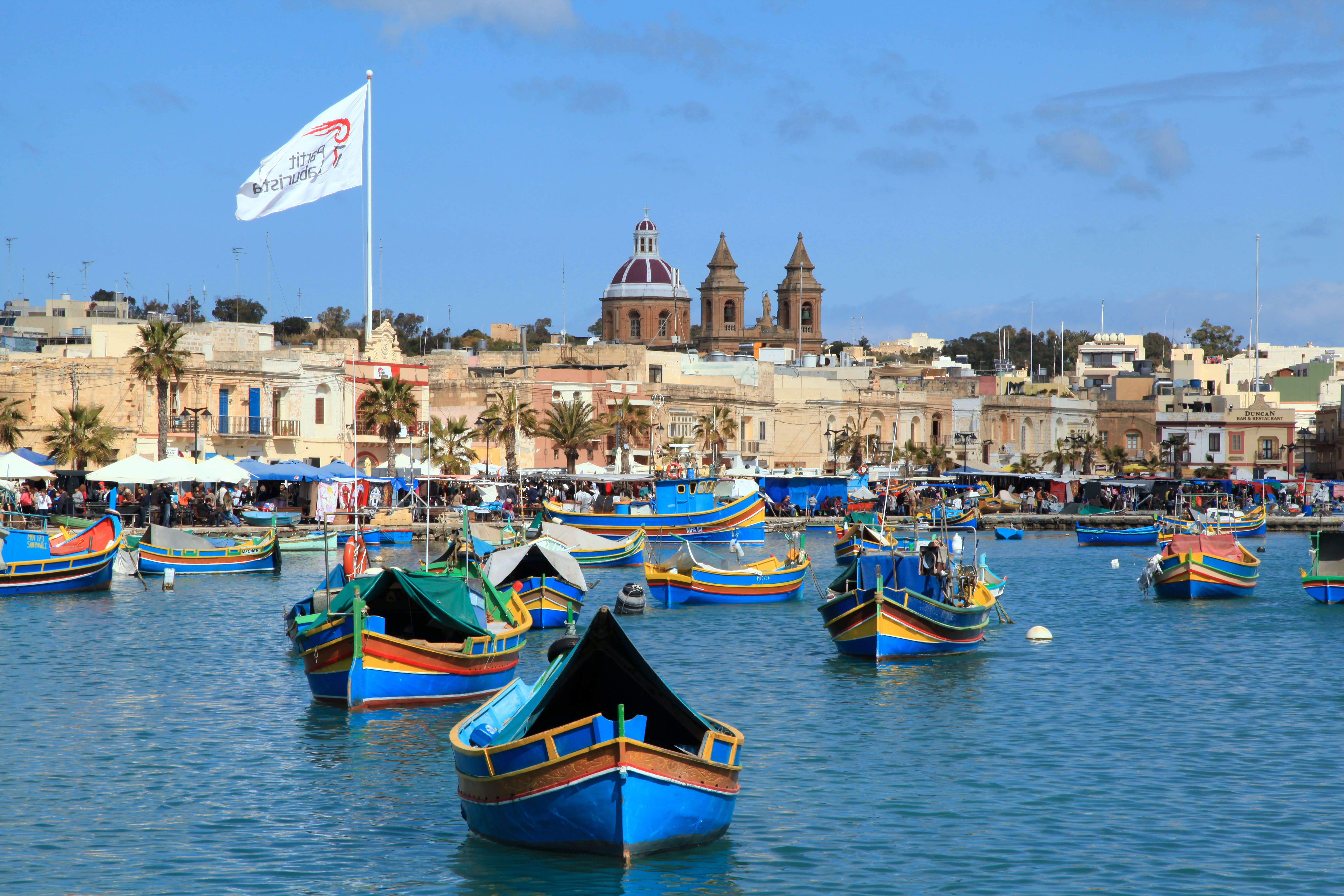luzzu on:
[Wikipedia]
[Google]
[Amazon]
 A ''luzzu'' (; ) is a
A ''luzzu'' (; ) is a
 The Italian ''gozzo'' visited Malta frequently in the 1880s, and the design of the ''luzzu'' is believed to have evolved from it in the early 20th century. The boat is also similar to the Maltese '' ferilla'', but it has a higher freeboard and a shorter stem and is made of stronger timber.
On 30 October 1948, an overloaded ''luzzu'' that was being used to ferry passengers from Malta to Gozo capsized and sank off Ħondoq ir-Rummien, and 23 people were killed.
Early ''luzzijiet'' were mainly used as transport vessels, but after they were motorised, they became popular as fishing boats. Modern versions of the boats have a deck, and some have a cabin. Today, no new ''luzzijiet'' are built, but a few hundred boats are still in operation, particularly at
The Italian ''gozzo'' visited Malta frequently in the 1880s, and the design of the ''luzzu'' is believed to have evolved from it in the early 20th century. The boat is also similar to the Maltese '' ferilla'', but it has a higher freeboard and a shorter stem and is made of stronger timber.
On 30 October 1948, an overloaded ''luzzu'' that was being used to ferry passengers from Malta to Gozo capsized and sank off Ħondoq ir-Rummien, and 23 people were killed.
Early ''luzzijiet'' were mainly used as transport vessels, but after they were motorised, they became popular as fishing boats. Modern versions of the boats have a deck, and some have a cabin. Today, no new ''luzzijiet'' are built, but a few hundred boats are still in operation, particularly at
 A ''luzzu'' (; ) is a
A ''luzzu'' (; ) is a traditional fishing boat
Traditionally, many different kinds of boats have been used as fishing boats to catch fish in the sea, or on a lake or river. Even today, many traditional fishing boats are still in use. According to the United Nations Food and Agriculture Org ...
from the Maltese
Maltese may refer to:
* Someone or something of, from, or related to Malta
* Maltese alphabet
* Maltese cuisine
* Maltese culture
* Maltese language, the Semitic language spoken by Maltese people
* Maltese people, people from Malta or of Maltese ...
islands. This type of boat developed in the early 20th century, although it is very similar to much older traditional Maltese boats such as the '' ferilla''. They are usually painted in bright colours, while the bow has a pair of eyes.
Name
The word ''luzzu'' is derived perhaps from the Sicilian ''guzzu'', which itself should be cognate withItalian
Italian(s) may refer to:
* Anything of, from, or related to the people of Italy over the centuries
** Italians, a Romance ethnic group related to or simply a citizen of the Italian Republic or Italian Kingdom
** Italian language, a Romance languag ...
. A ''guzzu'' is a common fishing or transport vessel used in Italy and Sicily.
History
 The Italian ''gozzo'' visited Malta frequently in the 1880s, and the design of the ''luzzu'' is believed to have evolved from it in the early 20th century. The boat is also similar to the Maltese '' ferilla'', but it has a higher freeboard and a shorter stem and is made of stronger timber.
On 30 October 1948, an overloaded ''luzzu'' that was being used to ferry passengers from Malta to Gozo capsized and sank off Ħondoq ir-Rummien, and 23 people were killed.
Early ''luzzijiet'' were mainly used as transport vessels, but after they were motorised, they became popular as fishing boats. Modern versions of the boats have a deck, and some have a cabin. Today, no new ''luzzijiet'' are built, but a few hundred boats are still in operation, particularly at
The Italian ''gozzo'' visited Malta frequently in the 1880s, and the design of the ''luzzu'' is believed to have evolved from it in the early 20th century. The boat is also similar to the Maltese '' ferilla'', but it has a higher freeboard and a shorter stem and is made of stronger timber.
On 30 October 1948, an overloaded ''luzzu'' that was being used to ferry passengers from Malta to Gozo capsized and sank off Ħondoq ir-Rummien, and 23 people were killed.
Early ''luzzijiet'' were mainly used as transport vessels, but after they were motorised, they became popular as fishing boats. Modern versions of the boats have a deck, and some have a cabin. Today, no new ''luzzijiet'' are built, but a few hundred boats are still in operation, particularly at Marsaxlokk
Marsaxlokk () is a small, traditional fishing village in the Southern Region, Malta, Southern Region of Malta. It has a harbour, and is a tourist attraction known for its views, fishing and history. As of March 2014, the village had a populati ...
. Some ''luzzijiet'' have been converted to passenger carriers for tourists, although the vast majority continue to be used as fishing vessels.
Description
The ''luzzu'' is a sturdy,carvel-built
Carvel built or carvel planking is a method of boat building in which hull planks are laid edge to edge and fastened to a robust frame, thereby forming a smooth surface. Traditionally the planks are neither attached to, nor slotted into, each ...
boat with a double-ended hull. Originally, the ''luzzu'' was equipped with oars and sails, although nowadays, almost all are motorised, with onboard diesel engine
The diesel engine, named after the German engineer Rudolf Diesel, is an internal combustion engine in which Combustion, ignition of diesel fuel is caused by the elevated temperature of the air in the cylinder due to Mechanics, mechanical Compr ...
s being the most common.
The boats are brightly painted in shades of yellow, red, green and blue, and the bow is normally pointed with a pair of eyes. These eyes may be the modern survival of an ancient Phoenician custom (also practised by the ancient Greeks
Ancient Greece () was a northeastern Mediterranean civilization, existing from the Greek Dark Ages of the 12th–9th centuries BC to the end of classical antiquity (), that comprised a loose collection of culturally and linguistically re ...
and Egyptians); they are referred to as the Eye of Horus
The Eye of Horus, also known as left ''wedjat'' eye or ''udjat'' eye, specular to the Eye of Ra (right ''wedjat'' eye), is a concept and symbol in ancient Egyptian religion that represents well-being, healing, and protection. It derives from th ...
or of Osiris
Osiris (, from Egyptian ''wikt:wsjr, wsjr'') was the ancient Egyptian deities, god of fertility, agriculture, the Ancient Egyptian religion#Afterlife, afterlife, the dead, resurrection, life, and vegetation in ancient Egyptian religion. He was ...
. They are said to protect the fishermen while at sea.
In 2016, Prof. Anthony Aquilina from the University of Malta determined that there are some traditional rules that come into play when choosing the colour palette for a ''luzzu''.
Whilst reddish brown or maroon was typically painted on the lower half of the boat to mark the waterline, the locality of a boat’s owner could be identified by the colour of its mustaċċ. The mustaċċ is the band above the lower half of the boat, shaped like a moustache, which gives the feature its name. A red mustaċċ would indicate that the boat came from St Paul’s Bay, for example. A lemon yellow indicated a boat from Msida or St Julian’s, whilst an ochre yellow one would identify the boat as hailing from the Marsaxlokk and Marsascala area. When a mustaċċ was painted black, it denoted mourning for a death in the family.The town of
Marsaxlokk
Marsaxlokk () is a small, traditional fishing village in the Southern Region, Malta, Southern Region of Malta. It has a harbour, and is a tourist attraction known for its views, fishing and history. As of March 2014, the village had a populati ...
is especially famous for the large numbers of ''luzzu'' and similar craft operating in its harbour. The ''luzzu'' is often considered a symbol of Malta.
References
External links
* {{Fisheries and fishing Boat types Culture of Malta Maritime history of Malta Types of fishing vessels